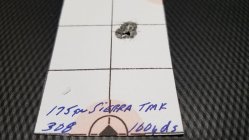If the load shot sub-half MOA at 100 yards and 4-5" at 300 yd, it was most likely you, or the wind, or both. 300 yd is simply not sufficient distance for that kind of dispersion to occur due to lack of positive comepensation, velocity variance, or any of the other major load tuning aspects we typically focus on for long range shooting. We're talking about a 3-fold increase in relative angular dispersion here, possibly even a bit more. At one time, I had a barrel on a .223 Rem F-TR rifle that had something faulty with the chamber so that it exhibited crazy high velocity extreme spreads. Even with ES values in the 60-90 fps range, that rifle could readily shoot cleans at 300 yd in benign conditions (i.e. < 1.5 groups). My point is that even with some major issues, a load that will shoot sub-half MOA at 100 yd shouldn't totally fall apart at 300 yd, even with some pretty major issues.
@Texas Solo - based on your description, I would ask the following questions:
1) Are you absolutely certain the rifle/load is still firing sub-half MOA groups at 100 yd? In other words, could something have changed between the time you shot those groups at 100 yd during load testing and your later experience at 300 yd?
2) What is your experience shooting groups at distances of 300 yd or farther? Is this a new aspect of shooting for you, or do you shoot at distances longer than 100 yd regularly? What kind of groups would you typically expect to shoot at 300 yd with a well-tuned load?
3) Were you using wind flags of some sort while shooting at 300 yd?
The bottom line is that something caused a pretty major difference in group spread between 100 and 300 yd. What you have to do now is root out the cause. In cases like this, isolating
one variable at a time is often critical to finding the culprit. So if you're positive the load as developed is still capable of shooting sub-half MOA groups at 100 yd, you can do some testing to try and identify the reason why it shoots poorly at 300 yd.
I would start with repeating the 300 yd test, being as careful as you possibly can, and using wind flags. Then is really a matter of picking apart the possible causes, then isolating and testing each variable. To be honest, I'm not sure that in your shoes, I would necessarily go down this road immediately. You mentioned sparing your 185s until you solve this issue. However, loading the 185s might actually provide some insight. At the very least, a 185 load might serve as a good "control" with which to compare the 168 results. For example, if you tune up a 185 load that shoots well at both 100 and 300 yd, that might suggest there really is something wrong with the 168 load, as opposed to being shooter error. It is not possible from the available information to state with absolute certainty there couldn't be something wrong with the Lot of 168s you have. I dont' think that's the most likely explanation, but it can't be entirely ruled out. On the other hand, a similar result with both bullets might suggest shooter error as it's unlikely you could work up loads with two totally different bullets that could shoot sub-half MOA at 100 yd, but that both then opened up to >/= 3 MOA at 300 yd. That would suggest a shooter-based issue. Letting someone else whose shooting skills you trust shoot the 168 load at 100 and 300 yd might not be a bad idea, either.
In the end, problems such as this may sometimes require tedious, even painful dissection, one variable at a time, before the root cause is uncovered. It can sometimes be worth it to trouble shoot everything, but sometimes it is easier just to move on. Best of luck with it!











